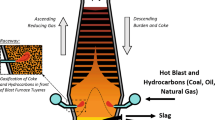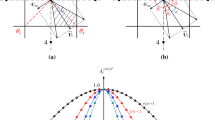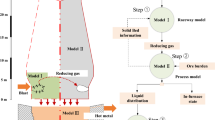Abstract
Blast furnaces remained the primary producer of hot metal iron despite the competition posed by alternating iron-making processes for the last 50 years. Possibly, when the hydrogen economy becomes a reality, its importance may fade sometime in the distant future. Mathematical modeling and simulation played a crucial role in gaining insights and thereby helped to optimize the process. Authors opine that commercial CFD packages do not offer enough flexibility to incorporate additional physics needed to develop simulation tools for complex processes like a blast furnace. Also, such solutions are not amenable to online deployment for use in operations. Thus, most of the models presented in the literature were developed from scratch by various researchers. However, these codes are neither efficient in computation, suitable for a parallel run nor better in robustness. In this context, to take advantage of new computational paradigms in terms of flexibility offered through open-source codes, in conjunction with parallelization, a comprehensive 2D blast furnace model has been developed using OpenFOAM®. In essence, it has opened a new pathway towards achieving an online digital twin for a complex process such as a blast furnace. The researchers have used standard heat, mass, and momentum balance equations. However, equations do differ when it comes to reaction kinetics, melting phenomena, etc. In the present study, the melting model uses the beginning of softening and the end of melting temperatures to calculate the liquid fraction formed, which is linearly changing with temperature. This has resulted in improved convergence. The model equations and their implementation in OpenFOAM® are presented in detail. As opposed to the prior art of the blast furnace simulation models, the present study demonstrates the grid independence, as well as the convergence of the fusion zone. The model predicts the size and shape of the cohesive zone and is shown to be capable of simulating various scenarios involving different burden distributions and other operating parameters through a parametric study.



















Similar content being viewed by others
Abbreviations
- \(\alpha\) :
-
Correction coefficient for moving packed bed [–]
- \(\gamma\) :
-
Surface tension coefficient [kg/s2]
- \(\varepsilon\) :
-
Voidage [–]
- \(\rho\) :
-
Density [kg/m3]
- \(\mu\) :
-
Dynamic Viscosity [kg/ms]
- \(\emptyset\) :
-
Velocity potential [N/m2]
- \(\phi\) :
-
Shape factor [–]
- \(\sigma\) :
-
Specific surface area for particles [m−1]
- \(\zeta\) :
-
Fraction of area available for heat transfer [–]
- \(\vartheta\) :
-
Volume fraction [m3/m3]
- \(\ell\) :
-
Correction coefficient for melting [–]
- \(\Delta v\) :
-
Cell volume [m3]
- \(\vec{G}\) :
-
Mass flux [kg/m2s]
- \(H\) :
-
Enthalpy [J/kg]
- \(M\) :
-
Molecular weight [kg/kmol]
- \(K\) :
-
Conductance in flow [m4/Ns]
- \(P\) :
-
Pressure [Pa]
- \(R\) :
-
Universal gas constant [J/kmolK]
- \(\dot{S}\) :
-
Mass source term [kg/m3s]
- \(\vec{S}\) :
-
Particle position vector [m]
- \(T\) :
-
Temperature [K]
- \(\vec{U}\) :
-
Velocity [m/s]
- X:
-
Volume fraction of a species in gas [–]
- \(Y\) :
-
Species mass fraction [–]
- \(\dot{V}\) :
-
Volumetric melting source term [m3/m3s]
- \({\text{Cp}}\) :
-
Specific heat [J/kgK]
- Nu:
-
Nusselt number [–]
- Pr:
-
Prandtl number [–]
- Re:
-
Reynolds number [–]
- Sc:
-
Schmidt number [–]
- c :
-
Correction coefficient in rate equation [–]
- \(\dot{d}\) :
-
Particle diameter [m]
- \(f_{1}\) :
-
Viscous resistance [kg/m3s]
- \(f_{2}\) :
-
Inertial resistance [kg/m4]
- \(h\) :
-
Heat transfer coefficient
- \(k\) :
-
Thermal conductivity [kg m/K3s]
- \(p\) :
-
Partial pressure [Pa]
- \({\text{d}}t\) :
-
Time step [s]
- \({\text{ke}}\) :
-
Equilibrium constant
- \({\text{kc}}\) :
-
Reaction rate constant
- \({\text{km}}\) :
-
Mass transfer coefficient
- \(a\) :
-
Activity coefficient
- \(g\) :
-
Gas
- l :
-
Liquid
- p :
-
Particle
- \(s\) :
-
Solid
- \(v \) :
-
Volumetric
- \(g - s\) :
-
Gas to solid
- \(g - l\) :
-
Gas to liquid
- \(s - l\) :
-
Solid to liquid
- \({\text{ore}}\) :
-
Ore in solids
- \({\text{coke}}\) :
-
Coke in solids
- melt:
-
Melting
- soft:
-
Softening
- ref:
-
Reference
- Ri:
-
Reaction number ‘i’
References
Online document: India In-depth review 2020, by IEA, https://www.iea.org/reports/india-2020. Accessed 1st Dec. 2021), p. 82.
A. Garg, P.R. Shukla, B. Kankal, and D. Mahapatra: Carbon Manag., 2017, vol. 8, pp. 111–23. https://doi.org/10.1080/17583004.2017.1306406.
S. Ueda, S. Natsui, H. Nogami, J. Yagi, and T. Ariyama: ISIJ Int., 2010, vol. 50, pp. 914–23.
P.B. Abhale, N.N. Viswanathan, and H. Saxén: Miner. Process. Extr Metall., 2020, vol. 129, pp. 166–83. https://doi.org/10.1080/25726641.2020.1733357.
S. Kuang, Z. Li, and A.B. Yu: Steel Res. Int., 2018, vol. 89(1), pp. 1–25. https://doi.org/10.1002/srin.201700071.
A. Rist and N. Meysson: JOM, 1967, vol. 19, pp. 50–59. https://doi.org/10.1007/bf03378564.
J.G. Peacey and W.G. Davenport: The Iron Blast Furnace, Pergamon Press Ltd., Oxford, 1979.
J. Yagi and I. Muchi: Trans. ISIJ, 1970, vol. 10(5), pp. 181–87.
C. Fielden and B. Wood: J. Iron Steel Inst., 1968, vol. 192, p. 650.
M. Hatano and K. Kurita: Trans. ISIJ, 1982, vol. 22, pp. 448–56.
J. Yagi, K. Takeda, and Y. Omori: Trans. ISIJ, 1982, vol. 22, pp. 884–92. https://doi.org/10.2355/isijinternational1966.22.884.
H. Nogami, M. Chu, and J. Yagi: Appl. Math. Model., 2006, vol. 30, pp. 1212–28.
H. Nogami, M. Chu, and J. Yagi: Comput. Chem. Eng., 2005, vol. 29, pp. 2438–48. https://doi.org/10.1016/j.compchemeng.2005.05.024.
J. Chen, T. Akiyama, and J. Yagi: ISIJ Int., 1992, vol. 32(12), pp. 1259–67. https://doi.org/10.2355/isijinternational.32.1259.
J. Chen, T. Akiyama, H. Nogami, J. Yagi, and H. Takahashi: ISIJ Int., 1993, vol. 33(6), pp. 664–71. https://doi.org/10.2355/isijinternational.33.664.
P.R. Austin, H. Nogami, and J. Yagi: ISIJ Int., 2008, vol. 37, pp. 748–55. https://doi.org/10.2355/isijinternational.37.748.
P.R. Austin, H. Nogami, and J. Yagi: ISIJ Int., 1997, vol. 37, pp. 458–67. https://doi.org/10.2355/isijinternational.37.458.
J.A. de Castro, H. Nogami, and J. Yagi: ISIJ Int., 2008, vol. 42, pp. 1203–211. https://doi.org/10.2355/isijinternational.42.1203.
J.A. De Castro, C. Takano, and J. Yagi: J. Mater. Res. Tech., 2017, vol. 6, pp. 258–70. https://doi.org/10.1016/j.jmrt.2017.05.007.
T. Sugiyama, M. Naito, S. Matsuzaki, H. Kumaoka, and T. Nakayama: CAMP-ISIJ, 1994, vol. 7, p. 46.
S. Matsuzaki, T. Nishimura, A. Shinotake, K. Kunitomo, M. Naito and T. Sugiyama: Nip. Steel Tech. Rep., 2006, no. 94, pp. 87–95.
M. Naito, A. Okamoto, K. Yamaguchi, T. Yamaguchi and Y. Inoue: Nip. Steel Tech. Rep., 2006, no. 94, pp. 103–08.
B. Burke and J. Burgess: 48th Ironmaking Conf., ISS AIME, Warrendale, PA, 1989, pp. 773–81.
S. Chew, P. Zulli, and A.B. Yu: ISIJ Int., 2001, vol. 41, pp. 1122–30.
X. Dong, A.B. Yu, S. Chew, and P. Zulli: Metall. Mater. Trans. B, 2010, vol. 41B, pp. 330–49.
G. Danloy, J. Mignon, R. Munnix, G. Dauwels and L. Bonte: 60th Ironmaking Conference Proceedings, Baltimore, 2001, pp. 37–48.
G. Danloy: 4th Ulcos Seminar, October 2008, pp. 1–4.
K. Yang, S. Choi, J. Chung, and J. Yagi: ISIJ Int., 2010, vol. 50, pp. 972–80.
X. Yu and Y. Shen: Metall. Mater. Trans. B, 2018, vol. 49B, pp. 2370–88.
A.K. Lahiri and V. Seshadri: J. Iron Steel Inst., 1969, vol. 207, p. 293.
P.B. Abhale: Modeling of Ironmaking Blast Furnace, Ph.D Thesis, Indian Institute of Technology, Bombay, India, 2011.
P.B. Abhale, N.N. Viswanathan, and N.B. Ballal: Comput. Mater. Contin., 2009, vol. 10(2), pp. 195–216.
Online document: OpenFOAM Documentation, https://openfoam.com/documentation/guides/latest/doc/index.html. Accessed 1st Dec 2021.
P.B. Abhale, Y. Bapat, N.N. Viswanathan, S. Nag: Adv. Process Metall. IISc Bangalore, India, 2019, pp. 1–11.
D.A. Bennett and R. Bradley: Appl. Math. Model., 1991, vol. 15, pp. 506–15.
R.H. Spitzer, F.S. Manning, and W.O. Philbrook: Trans. Metall. Soc. AIME, 1966, vol. 236, pp. 1715–24.
Y. Omori: Committee on Reaction within Blast Furnace, The Iron and Steel Institute of Japan, Blast Furnace Phenomenon and Modelling, Elsevier Applied Science Publishers LTD., England, 1987, p. 127.
A.K. Biswas: Principles of Blast Furnace Iron Making: Theory and Practice, Cootha Publishing House, Brisbane, 1981.
S.V. Patankar: Numerical Heat Transfer and Fluid Flow, Hemisphere Publishing Corporation, New York, 1980.
Acknowledgments
The authors thank Tata Steel Management for allowing us to publish the present work.
Competing interest
The authors declare that there have no known competing financial interests or personal relationships that could have appeared to influence the work reported in this paper.
Author information
Authors and Affiliations
Corresponding author
Additional information
Publisher's Note
Springer Nature remains neutral with regard to jurisdictional claims in published maps and institutional affiliations.
Appendix A: Method for Generation of STL file to represent layer in blast furnace
Appendix A: Method for Generation of STL file to represent layer in blast furnace
A ‘STL’ (an abbreviation for stereolithography) is a method used in Computer Aided Design to represent 3-dimensional surfaces by triangulation method. For layer surface triangulation, an utility program is written in python language, which use point cloud locations obtained from the ‘icoUncoupled KinematicParcelFoam’[33] as an input. The format of such position coordinates generated in first step is as shown in Figure A1.
For simplicity, consider 10 points per line and 4 lines corresponding to a three-layered profile, as shown in Figure A2 below:
In the STL creation utility, during the first step, triangles are generated between two consecutive lines i.e., line 1 and line 2, line 2 and line 3, line 3 and line 4, as shown by the example snapshot in Figure A3.
In the second step, these points are then offset in surface normal direction, by user specified thickness, so that the STL with a given thickness is generated, as shown in Figure A4.
The closed STL is then created from these two surfaces by triangulating top, bottom, left and right surfaces. The STL file is written as multiple blocks of triangles, out of which a single block is as shown in Figure A5. The closed layer interfaces and layer volumes thus generated are depicted in Figure A6, using isometric view.
Rights and permissions
Springer Nature or its licensor holds exclusive rights to this article under a publishing agreement with the author(s) or other rightsholder(s); author self-archiving of the accepted manuscript version of this article is solely governed by the terms of such publishing agreement and applicable law.
About this article
Cite this article
Abhale, P.B., Nag, S., Bapat, Y. et al. Development of 2D Steady-State Mathematical Model for Blast Furnace Using OpenFOAM®. Metall Mater Trans B 53, 3469–3491 (2022). https://doi.org/10.1007/s11663-022-02610-6
Received:
Accepted:
Published:
Issue Date:
DOI: https://doi.org/10.1007/s11663-022-02610-6










